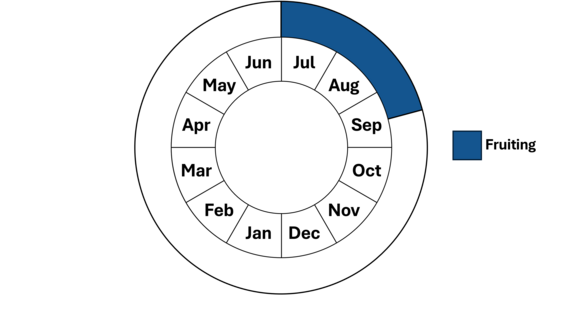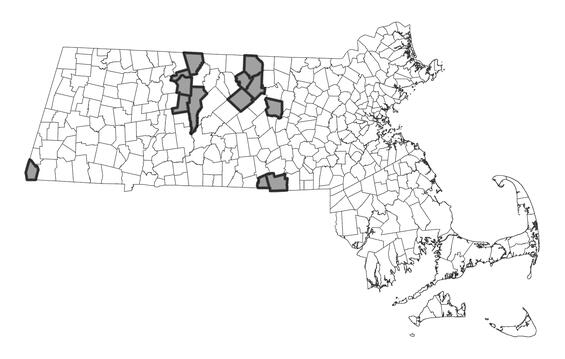- Scientific name: Potamogeton confervoides
- Species of Greatest Conservation Need (MA State Wildlife Action Plan)
- Threatened (MA Endangered Species Act)
Description
Tuckerman's pondweed, Potamogeton confervoides, is a delicate aquatic member of the pondweed family (Potamogetonaceae) that grows completely submerged in lakes and ponds. It grows as fans of highly branched thread-like stems with long, flaccid, thread-like leaves. The upright stems, which are so delicate they collapse into a clumped mass when removed from the water, are arranged along elongate rhizomes (horizontal underground stems). Long peduncles (flower and fruit-bearing stalks) emerging from the tips of the stems each have a small (5-12 mm diameter; 0.20-0.47 in) globular fruiting head. The species reproduces by seed, clonal expansion from rhizomes, turions (vegetative buds that detach from the parent plant and disperse through the water), and probably from stem fragments. Although the pondweeds (Potamogeton spp.) are the largest and most technically challenging group of aquatic plants in our flora, Tuckerman's pondweed is distinctive and readily identified in the field.
Aids to identification:
- Leaves are exceptionally fine, 1.8-6.5 cm long x 0.1-0.5 mm wide (0.71-2.56 in long × 0.004-0.02 in wide)
- Peduncles are 5-25 cm (2-10 inches) long, much longer than other pondweeds
- Leafy stems are widely spaced along rhizomes
The combination of very fine thread-like leaves and long peduncles bearing globular fruit clusters is distinctive. When not fruiting, several other fine-leaved aquatic species might be mistaken for Tuckerman's pondweed, particularly snail-seed pondweed (Potamogeton bicupulatus) before it produces floating leaves later in the season.
Life cycle and behavior
Tuckerman’s pondweed is a perennial aquatic plant that may start to flower in mid-June depending on water temperatures and sun exposure and will continue through the end of August. Mature fruits/seed can be found in September.

Population status
Tuckerman's pondweed is listed under the Massachusetts Endangered Species Act as Threatened. All listed species are protected from killing, collecting, possessing, or sale, and from activities that would destroy habitat and thus directly or indirectly cause mortality or disrupt critical behaviors. Tuckerman's pondweed has been verified since 1999 in 20 populations found in Berkshire, Franklin, and Worcester Counties and was known historically from Middlesex, Norfolk, Bristol, and Plymouth Counties. Extant populations are concentrated in Worcester County.
Distribution and abundance
Tuckerman's pondweed is rare throughout much of its range, which is centered on the Atlantic coastal plain from Labrador and Newfoundland south to disjunct populations in North and South Carolina. Outlying populations are found in the northern Great Lakes region. In New England, it is possibly extirpated in Rhode Island, critically imperiled in Connecticut, imperiled in Massachusetts and Vermont, and vulnerable in New Hampshire. Maine has not assessed the populations in its state. (NatureServe, 2025).

Distribution in Massachusetts. 1999-2024. Based on records in the Natural Heritage Database.
Habitat
Tuckerman's pondweed is limited to acidic water bodies including mill ponds, reservoirs, and natural lakes and ponds. One population is in flowing water in a rocky-bottomed brook. In other parts of its range, Tuckerman's pondweed is often found in tannin-rich bog ponds, and the species might be looked for in similar habitat in Massachusetts. Tuckerman's pondweed is a habitat generalist (except for its intolerance of alkaline waters) and can be found growing on a variety of substrates ranging from soft muck to mineral substrates. Exposures range from sheltered coves to wave-swept shores. Populations occur in water bodies with varied nutrient regimes, from sparsely vegetated, clear oligotrophic lakes to densely vegetated, moderately eutrophic ponds.
Healthy habitats are vital for supporting native wildlife and plants. Explore habitats and learn about conservation and restoration in Massachusetts.
Threats
Although the competitive ability of Tuckerman's pondweed is unknown, there is concern about the long-term persistence of populations in eutrophic ponds where dense beds of aggressive aquatic plants occur. Two historic populations where the species has not been relocated in recent surveys were in ponds that are now eutrophic and heavily overgrown with native and introduced species.
Conservation
Populations in densely vegetated ponds should be monitored regularly, and management to reduce the density of other aquatic species should be considered if declines are documented. All active management of rare plant populations (including invasive species removal) is subject to review under the Massachusetts Endangered Species Act and should be planned in close consultation with the MassWildlife’s Natural Heritage & Endangered Species Program.
References
Crow, G.E. and C.B. Hellquist. Aquatic and Wetland Plants of Northeastern North America. Volume Two Angiosperms: Monocotyledons. 2000. The University of Wisconsin Press. Madison Wisconsin.
Flora of North America Editorial Committee. 2000. Flora of North America, North of Mexico. Volume 22: Magnoliaphyta: Alismatidae, Arecidae, Commelinidae (in part), and Zingiberidae. Oxford Univ. Press. New York, NY.
NatureServe. 2025. NatureServe Network Biodiversity Location Data accessed through NatureServe Explorer [web application]. NatureServe, Arlington, Virginia. Available https://explorer.natureserve.org/. Accessed: 4/30/2025.
Penskar, M.R. 2009. Special Plant Abstract for alga pondweed (Potamogeton confervoides). Michigan Natural Features Inventory, Lansing, MI
Contact
| Date published: | May 5, 2025 |
|---|